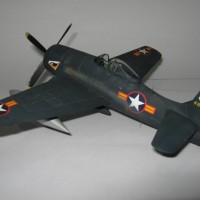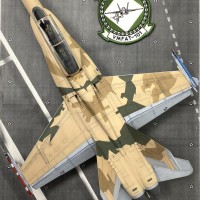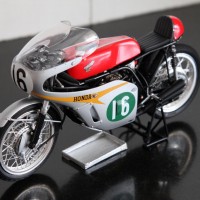Revell 1/32 F-18A
The origins of the F/A-18 can be traced back in summer 1973, where the Secretary of Defense James R. Schlesinger ordered the Navy to evaluate the YF-16 and YF-17 competitors in the Air Force's Lightweight Fighter (LWF) program, in order to pursue a lower-cost alternative to their F-14. Being skeptical about the YF-16's only one engine and narrow landing gear, the Navy, on 2 May 1975 announced its selection of the YF-17. Of course, the plane had to become carrier capable and for this, the Navy approached the experienced McDonnell Douglas to team with Northrop. The F-18 was born.
Both companies agreed to evenly split component manufacturing, with McDonnell Douglas conducting the final assembly. Northrop would be the prime contractor for the denavalized F-18L land based version which hoped to sell on the export market, while McDonnell Douglas would go for the naval version, which was initially known as McDonnell Douglas Model 267 and eventually named “Hornet” by Secretary of the Navy W. Graham Claytor.
As it turned out, apart from the general layout, the navalized F-18 had little in common with the YF-17. It was bigger, stronger, more aerodynamically refined and incorporated an innovative quadruple redundant digital Fly-By-Wire system. It would not be too much of an exaggeration to say that it was a different plane.
Though initially three naval variants were envisaged (the single seaters F-18A and A-18A fighter and attacker respectively and the dual-seat TF-18A), improvements in avionics made possible to combine the two former in one aircraft, which was designated F/A-18A, with the dual seater redesignated F/A-18B.
By all means a “modern” design, the Hornet's relatively high thrust-to-weight ratio, combined with its advanced aerodynamics and flight controls made the plane highly maneuverable. Its multifunction displays and digital multiplexing avionics buses further enhanced its combat capability, with its not too demanding maintenance and high reliability being the icing on the cake.
Very early in its career the F/A-18 went through some aerodynamic refinements, mainly filling the snag on the leading edge of the stabilators, reducing by roughly 80% the gap between the leading-edge extensions (LEX) and, finally, adding a small vertical fence on top of each LEX to broaden the vortices and direct them away from the vertical stabilizers.
In the meantime, Northrop was developing its land based F-18L as a potential export aircraft. Not needing the strength and other naval requirements, the machine would be lighter and better performing, aiming to compete with the F-16 then being offered to American allies. Things became complicated upon McDonnel Douglas's promotion of a lightened version of their own F/A-18A as a land based export alternative, with the partnership between the two companies going through a rocky road, including lawsuits and the like. By the time a settlement had been made (which, among others, allowed McDonnell Douglas to market their devavalized F/A-18 by paying $50m to Northrop), Northrop's F-18L project had been terminated.
The Hornet first saw combat action during the 1986 United States bombing of Libya and subsequently participated in the 1991 Gulf War and 2003 Iraq War. In combat, the plane excelled, exhibiting outstanding (for a tactical aircraft) availability, reliability, and maintainability, with its versatility allowing it, for example, to shoot down enemy fighters and subsequently bomb enemy targets with the same aircraft on the same mission!
During the 90s the F/A-18E/F Super Hornet was introduced, which was in fact a new, bigger plane, based on the design concepts of its predecessor. Still flying today (2024), the Hornet will eventually be replaced by the F-35C and F-35B variants for the Navy and Marines respectively.
Highly versatile, aerodynamically refined, maneuverable and able to carry a plethora of weapons, the Hornet could perform fighter escort, fleet air defense, suppression of enemy air defenses, air interdiction, close air support and aerial reconnaissance. Though not without its trade-offs, it proved a good, reliable performer, a balanced machine that would become a valuable carrier asset.
BuNo 161214 was a pre-production example that was used as a test aircraft by the VX-4 “Air Test and Evaluation Squadron Four”. In the early 90s she was transferred to the NASA Dryden Flight Research Center, where she was used as a chase plane, providing valuable monitoring in many significant projects which included planes such as the X-29, X-31, SR-71 and B-52. From 1997 onwards, she is proudly on display at the JetHawks Stadium, Lancaster, California.
This is a particular case of a kit, as it can only represent a pre-production evaluation machine. If you want an operational 1/32 Hornet you should definitely opt for the 2003 Academy mold. That said, this Revell offering, while not featuring the level of detail one has to expect from a 1/32 modern jet, is not really a bad kit.
https://modelingmadness.com/review/mod/us/usn/fighter/penr18.htm
Happy Modelling!

















This was the second kit I ever made as an 8 year old...
Thank you so much, Maurits De Ridder @mauritsderidder!
An excellent history of the Hornet, Spiros, and a very clean looking model, must be quite a size in 1/32.
Thank you kindly, my friend @chinesegeorge! Yes, it does occupy some serious amount of shelf space.
Excellent job.
I built this kit as a kid (when it first came out) and it looked nothing like yours (mine looked like it was built by a spazzy 11 year old with no patience which it was.) However, I noticed the canopy fit is as terrible as I remember it (not a criticism of your build but of the actual kit... my rear canopy was warped outwards so the canopy frame stuck out from the fuselage... unfortunately a common issue with Revell kits of that era IIRC.)
Thanks so much, my friend @dbdlee! Indeed, the canopy did not fit that well, as were quite a few Revell canopies of the era. Not sure why this occured, maybe premature removal from the mold before sufficient cooling, or just plain "miss"?
Nice Hornet, Spiros!
Thabk you so much, my friend @gkittinger!
Nicely done Spiros @fiveten!
Thanks a lot, my friend @tolss!
Absolutely amazing result, Spiros @fiveten
Nicely presented with an informative article.
Lots of details in that interior, is that PE
Thank you very much, my friend @johnb! This is the stock kit interior.
Great job, Spiros. I like the subtle weathering. @fiveten
Thanks a lot, my friend @jdtruby!
You certainly are churning them out! Another great result.
Thank you kindly, my friend @christopher!
This is a huge plane in 1/32, Spiros (@fiveten). Looks great, and the paint and shadowing is very cool.
Thank you very much, my friend @gblair!
G’day Spiros (@fiveten),
When I first saw your pictures I thought there was something seriously wrong with the shape of the kit.
I consider myself to know a lot about the history of the Hornet, particularly in RAAF service and later developments and fixes, but I don’t recall seeing the original configuration as for this prototype version. So, you have educated me, which is always a welcome thing.
I don’t know the age of the moulds, but they seem relatively basic from your description. That said, you have done a wonderful job on this.
Liked!
Thsnk you so much, my friend @michaelt! Indeed, Revell (and Hasegawa) issued 1/32 Hornets in the late 70s. This meant that they had taken measurements from prototype/evaluation machines which differed notably from the final operational ones. This issue plagued those kits. Also, as a kit, the Revell comes closer to a budget 1/48 than a typical 1/32, regarding the level of detail.
@fiveten, I looked up my primary reference book and, now that I know what to look for, can see the “dog tooth” leading edge on both the wing and stabiliser on the first prototype.
Inerestingly, when Boeing scaled up the Hornet to make the Super Hornet, they revived the dog tooth on the wing.
In theory, the dog tooth generates a vortex that increases lift over the outer wing at higher angles of attack and maintains aileron control.
This is great info, my friend @michaelt! Indeed, it is quite interesting that Boeing revived the tooth on the wing. Makes one wondering whether deleting it was not an efficient move at first place.
Nice looking Hornet and very informative article. Thanks Spiros.
Thank you so much, my friend @gelleb18!
Your build does the great lines of the Hornet justice! Well done, Spiros
Thank you very much, my friend @gwskat!
Wow, amazing build, Spiros @fiveten! That must be huge. Very beautiful paintjob!
Thanks so much, my friend @fxrob! Yes, it is quite big!
Nice work on a big model, Spiros. It really looks like the early Hornet.
Thanks a lot, my friend @j-healy!
Nice work on this Spiros! Looks like a big one!
Thanks a lot, my friend @bapowellphys!
Yes, a big one!
So big beast!
Thanks a lot, my friend @lis! Yes! Big!
Great looking Hornet Spiros!
Thank you so much, my friend @roofrat!
That’s a heck of a huge, good looking Hornet, Spiros @fiveten. Well done!
Thank you very much, my friend @eb801!
Nicely done Spiros @fiveten, thanks for the article about this aircraft.
Thanks a lot, my friend @yann!